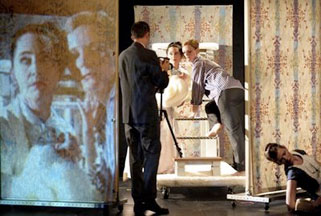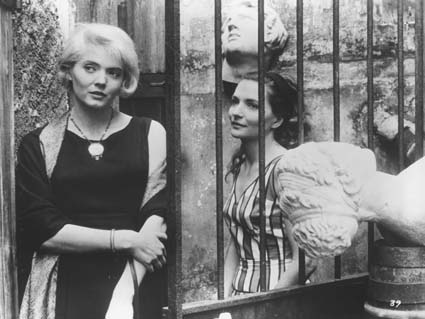
Big Dance Theater reinvents Varda classic onstage
The Kitchen
512 West 19th St. between Tenth & Eleventh Aves.
October 7-11, 8:00 (plus 3:00 matinee on 10/11)
Tickets: $15
212-255-5793
http://www.bigdancetheater.org
http://thekitchen.org
Agnès Varda’s 1961 Nouvelle Vague classic, CLÉO FROM 5 TO 7, is as much about filmmaking as it is about its subject, a small-time chanteuse wandering the streets of Paris as she fearfully awaits the results of a biopsy. New York-based Big Dance Theater, under the artistic direction of husband-and-wife team Annie-B Parson and Paul Lazar, reinvents the seminal real-time film onstage in the vastly entertaining COMME TOUJOURS HERE I STAND. Turning the process itself into the narrative, BDT creates a multimedia mix of dance, music, and video centered around the making of the film, with a diva star (Molly Hickok) playing the diva star. Parson and Lazar, who based the production on Varda’s screenplay — they didn’t watch the movie itself until things were well under way — brilliantly incorporate a wonderful set featuring three vertical multipurpose screens and a rolling staircase. Evoking New Wave master Jean-Luc Godard, much of the action takes place in between shots, “off camera,” involving the cast and crew, focusing on Cléo’s ever-more-frustrated costars, one of whom (Kourtney Rutherford) is in a continuing phone drama with her boyfriend.
Fans of the film won’t be disappointed — BDT includes all the familiar scenes, from visits to a fortune-teller and a hat shop to a musical interlude with Cléo’s pianist (Chris Giarmo, who plays numerous roles) and a walk in the park with a poetic soldier (Ryutaro Mishima). Refreshingly, COMME TOUJOURS HERE I STAND, which runs at the Kitchen through October 11, also maintains Varda’s focus on women’s experience and interaction with each other. Rare for the current New York stage, the production provides three major female roles, with fine performances from Hickok, Rutherford, and especially Tymberly Canale.

Varda film is Nouvelle Vague classic
CLEO FROM 5 TO 7 (CLÉO DE 5 À 7) (Agnès Varda, 1962)
Available on DVD
 After getting a biopsy taken and drawing the death card while consulting a fortune-teller, popular French singer Cléo (Corinne Marchand) begins looking back at her life — and wondering just what’s left of it — while awaiting the dreaded results. The blonde beauty talks with old friends, asks her piano player (Michel Legrand, who composed the score) to write her a song, and meets a dapper gentleman in the park, becoming both participant and viewer in her own existence. As Cléo makes her way around town, director (and former photographer) Agnès Varda shows off early 1960s Paris, expertly winding her camera through the Rive Gauche. Just as Cléo seeks to find out what’s real (her actual name is Florence and that gorgeous hair is a wig), Varda shoots the film in a cinema verité style, almost as if it’s a documentary. She even sets the film in real time (adding chapter titles with a clock update), enhancing the audience’s connection with Cléo as she awaits her fate, but the movie runs only ninety minutes, adding mystery to what is to become of Cléo, as if she exists both on-screen and off, alongside the viewer. A central film in the French Nouvelle Vague and one of the first to be made by a woman, CLÉO DE 5 À 7 is an influential classic even as it has lost a step or two over the years. Varda, now in her eighties, has also made such well-regarded films as LE BONHEUR (1965), VAGABOND (1985), THE GLEANERS AND I (2000), and THE BEACHES OF AGNÉS (2008), among others. Big Dance Theater has reimagined the film in a multimedia production, COMME TOUJOURS HERE I STAND, that runs at the Kitchen through October 11.
After getting a biopsy taken and drawing the death card while consulting a fortune-teller, popular French singer Cléo (Corinne Marchand) begins looking back at her life — and wondering just what’s left of it — while awaiting the dreaded results. The blonde beauty talks with old friends, asks her piano player (Michel Legrand, who composed the score) to write her a song, and meets a dapper gentleman in the park, becoming both participant and viewer in her own existence. As Cléo makes her way around town, director (and former photographer) Agnès Varda shows off early 1960s Paris, expertly winding her camera through the Rive Gauche. Just as Cléo seeks to find out what’s real (her actual name is Florence and that gorgeous hair is a wig), Varda shoots the film in a cinema verité style, almost as if it’s a documentary. She even sets the film in real time (adding chapter titles with a clock update), enhancing the audience’s connection with Cléo as she awaits her fate, but the movie runs only ninety minutes, adding mystery to what is to become of Cléo, as if she exists both on-screen and off, alongside the viewer. A central film in the French Nouvelle Vague and one of the first to be made by a woman, CLÉO DE 5 À 7 is an influential classic even as it has lost a step or two over the years. Varda, now in her eighties, has also made such well-regarded films as LE BONHEUR (1965), VAGABOND (1985), THE GLEANERS AND I (2000), and THE BEACHES OF AGNÉS (2008), among others. Big Dance Theater has reimagined the film in a multimedia production, COMME TOUJOURS HERE I STAND, that runs at the Kitchen through October 11.
